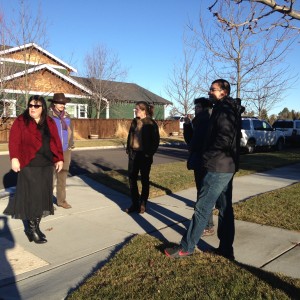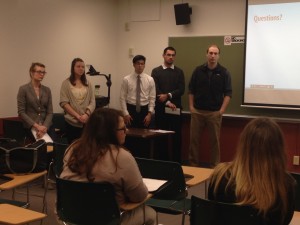For students in my Housing Policy class, this experience was different from their usual lectures and quizzes. The two teams, each made up of two grad students and three or four undergraduates, gained real-world experience throughout the Winter term and made recommendations to planners at the City of Redmond last week.
Earlier in the term I wrote about my experience teaching an experiential learning, project-based course through the University of Oregon’s Sustainable City Year Program, which allows instructors to build courses around the needs of a municipal partner. This year’s partner, the City of Redmond, identified their Affordable Housing Plan as one of the projects where they needed some help. Students in my class worked on two questions: the first group conducted a policy review of the Affordable Housing Plan, Comprehensive Plan and local policies on affordable housing in order to recommend strategies that the City could implement. The second group conducted interviews with local planners, non-profit housing providers and developers in order to determine the key issues in the provision of affordable housing in Redmond. Today, I will explain how the projects progressed throughout the Winter term (January-March).
We visited Redmond during the first week of January, hearing from city planners about the current Affordable Housing Plan (2007) and some challenges the city is facing in terms of lower than average median incomes, an increasing number of young families, and higher than average unemployment. With Heather Richards, Community Development Director at the City of Redmond, we toured several projects in the city that had been funded through housing tax credits for low-income housing, secondary units, and clustered units.
hearing from city planners about the current Affordable Housing Plan (2007) and some challenges the city is facing in terms of lower than average median incomes, an increasing number of young families, and higher than average unemployment. With Heather Richards, Community Development Director at the City of Redmond, we toured several projects in the city that had been funded through housing tax credits for low-income housing, secondary units, and clustered units.
Students worked on their projects each week–they had a lecture on Tuesdays, but on Thursdays they had time to work on their group projects, exploring key questions related to that week’s lecture. For example, during the week on housing for specific demographic groups, they explored whether an employer housing program developed in the UK might be applicable to the Redmond setting. Each group had two graduate students who served as the project managers, organizing meetings and ensuring that things stayed on track throughout the term.
For their interim deadline in Week 5 of the term, Group 1, who was conducting the policy analysis, prepared a framework showing the structure of the policies/plans, how they reinforced each other, and what affordable housing tools they wanted to investigate further. Group 2 wrote their interview guide and developed their list of participants based on some contacts the City had given them. They aimed to conduct 10-12 interviews, but in the end they completed fourteen.
Group 1 chose to investigate a number of affordable housing tools through the use of case studies, which they appended to their final report. They then determined whether the tool would be suitable for Redmond given its current policy framework, culture, and legal considerations. When the City planners, Chelsea Dickens and Katie McDonald, attended class presentations in Week 8, Group 1 used the feedback to help narrow down the tools to focus on. In the short term, they recommended gap financing, the development of an affordable housing trust (created through linkage fees, condominium conversion fee, and construction excise tax), waiving system development charges for affordable housing projects (funded through the trust), and changing the definition of dwelling units to include those with shared facilities and smaller sizes. Long-term suggestions included a housing dispersal policy, ensuring the use of clear standards for permit approval, adopting inclusionary zoning, and introducing employer assisted housing.
Group 2, in their first set of interviews, found that there was an increasing gap between the average housing prices and average income in Redmond. Some of the barriers to affordable housing identified by participants included NIMBYism and social stigma from the public and within the city government, the development code, and the low return on investment. Tools such as gap financing, decreasing the service development charges, and rent subsidies were discussed. Surprisingly, homelessness was an issue affecting Redmond, which does not currently have a homeless shelter. Hidden homelessness, with couch surfing or sleeping in cars, is becoming more common, although the City planners did not necessarily want to acknowledge or address this issue in the Affordable Housing Plan. Group 2 recommended the use of the housing continuum model to understand how different types of housing are needed, and pressure on one type of housing puts pressure on other types. In this case, the lack of affordable rental housing forces people into ownership before they are ready (Redmond had a much higher than average rate of foreclosures post-2008) and into precarious housing situations like couch-surfing.
was an increasing gap between the average housing prices and average income in Redmond. Some of the barriers to affordable housing identified by participants included NIMBYism and social stigma from the public and within the city government, the development code, and the low return on investment. Tools such as gap financing, decreasing the service development charges, and rent subsidies were discussed. Surprisingly, homelessness was an issue affecting Redmond, which does not currently have a homeless shelter. Hidden homelessness, with couch surfing or sleeping in cars, is becoming more common, although the City planners did not necessarily want to acknowledge or address this issue in the Affordable Housing Plan. Group 2 recommended the use of the housing continuum model to understand how different types of housing are needed, and pressure on one type of housing puts pressure on other types. In this case, the lack of affordable rental housing forces people into ownership before they are ready (Redmond had a much higher than average rate of foreclosures post-2008) and into precarious housing situations like couch-surfing.
In both groups, the need for a regional approach to affordable housing was raised, since Redmond is located near other small cities in Central Oregon: Bend, Sisters, Prineville, and Madras. Group 1 recommended that Redmond and Bend collaborate on a Consolidated Plan to help them access funding from Housing and Urban Development, while Group 2 recommended that the city foster partnerships between the non-profit housing providers, developers, and the city. Lack of public participation was also a significant issue, with both groups recommending more extensive public participation and involvement in a new Affordable Housing Plan. An Affordable Housing Advisory Committee would be a good idea to bring together stakeholders with different perspectives. Better communication, such as explanations of the various tools available to developers to build affordable housing, could be encouraged on the city’s website–developers and other stakeholders need to understand the different types of housing that could be built and the need for them in Redmond. During this term, Oregon’s state legislature approved inclusionary zoning, which will allow cities and counties to require developers to include low-income housing in new developments. The students made use of this exciting new policy development in their recommendations.
Students presented their final reports to the City via teleconference during Week 10 of the term, and submitted their final reports (download the Group 1 Report here, and Group 2 here). As is their usual practice, the Sustainable Cities Initiative office has hired two of the students compile the reports into a single document for future reference.
One of the issues students struggled with was the social stigma associated with affordable housing, particularly the issue of temporary housing and homelessness, among City staff. It was also apparent that communication and collaboration were at very low levels in Redmond compared to Eugene and Springfield, where recent efforts have led to a regional consolidated plan and HUD funding to address affordable housing. From an instructor standpoint, the course had to be front-loaded somewhat, so that students started with research methods (content analysis of the Affordable Housing Plan in Week 2 and developing their research tools by Week 5), with the theoretical material delivered later in the term. This worked fine for the Masters students, but not as well for the undergrads for whom the housing issues and theories were new. And of course, the ten-week term is extremely challenging for project scoping and completion. Overall, though, the students adapted to these conditions and were able to produce excellent work, gain an understanding of the constraints of policy development and implementation, and make some contacts in the planning field.
